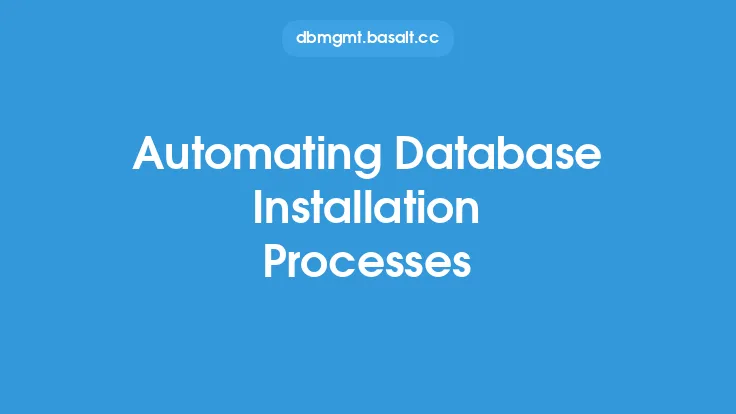When it comes to setting up a database, understanding the installation basics is crucial for a successful deployment. Database installation is a critical step in the overall database implementation process, as it lays the foundation for the database's performance, security, and scalability. In this article, we will delve into the fundamental concepts and principles of database installation, providing a comprehensive overview of the key considerations and technical aspects involved.
Introduction to Database Installation
Database installation involves a series of steps that prepare the database management system (DBMS) for use. This includes installing the DBMS software, configuring the database parameters, and setting up the necessary infrastructure. The installation process can vary depending on the type of database, the operating system, and the hardware platform. However, the underlying principles and concepts remain the same, and understanding these basics is essential for a successful installation.
Database Types and Installation Considerations
There are several types of databases, each with its own installation requirements and considerations. Relational databases, such as MySQL and Oracle, require a different installation approach than NoSQL databases, such as MongoDB and Cassandra. Additionally, cloud-based databases, such as Amazon Aurora and Google Cloud SQL, have their own set of installation considerations. Understanding the specific requirements of the chosen database type is critical to ensure a smooth installation process.
Database Hardware and Infrastructure
The hardware and infrastructure requirements for a database installation are critical to its performance and scalability. The database server should have sufficient CPU, memory, and storage resources to handle the expected workload. The storage subsystem should be designed to provide high-performance and low-latency data access, and the network infrastructure should be configured to provide reliable and secure connectivity. Understanding the hardware and infrastructure requirements is essential to ensure that the database is properly configured and optimized for performance.
Database Software Installation
The database software installation process involves installing the DBMS software, configuring the database parameters, and setting up the necessary tools and utilities. The installation process typically involves creating a database instance, configuring the database settings, and setting up the security parameters. The database software installation process can be complex, and understanding the technical aspects involved is critical to ensure a successful installation.
Database Configuration and Parameter Settings
Database configuration and parameter settings play a critical role in determining the database's performance, security, and scalability. The database configuration settings, such as the block size, buffer cache size, and sort area size, should be carefully tuned to optimize performance. The database parameter settings, such as the maximum number of connections, maximum memory allocation, and query timeout, should be configured to ensure reliable and secure operation. Understanding the database configuration and parameter settings is essential to ensure that the database is properly optimized and configured for the specific use case.
Database Security Considerations
Database security is a critical aspect of database installation, as it ensures the confidentiality, integrity, and availability of the data. The database should be configured to use secure authentication and authorization mechanisms, such as SSL/TLS encryption and role-based access control. The database should also be configured to use secure password storage and transmission protocols, such as password hashing and salting. Understanding the database security considerations is essential to ensure that the database is properly secured and protected against unauthorized access and data breaches.
Database Backup and Recovery
Database backup and recovery are critical aspects of database installation, as they ensure the availability and recoverability of the data in the event of a failure or disaster. The database should be configured to use a reliable backup and recovery mechanism, such as incremental backups and transaction logging. The database should also be configured to use a secure and reliable storage subsystem, such as a storage area network (SAN) or a cloud-based storage service. Understanding the database backup and recovery mechanisms is essential to ensure that the database is properly protected and recoverable in the event of a failure or disaster.
Conclusion
In conclusion, understanding database installation basics is critical to ensuring a successful deployment. The database installation process involves a series of complex technical steps, and understanding the fundamental concepts and principles involved is essential to ensure a smooth and successful installation. By understanding the database types and installation considerations, database hardware and infrastructure, database software installation, database configuration and parameter settings, database security considerations, and database backup and recovery mechanisms, database administrators can ensure that their databases are properly configured, optimized, and secured for reliable and high-performance operation.





